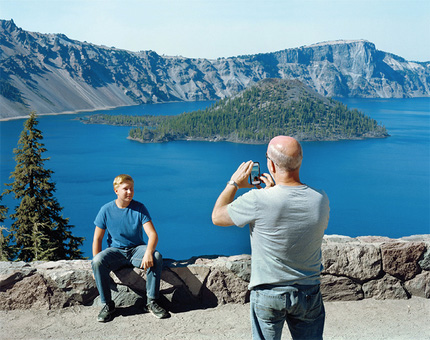
- Source: ARTFORUM
- Author: SUZANNE HUDSON
- Date: FEBRUARY, 2016
- Format: PRINT
David Benjamin Sherry
Review: Paradise Fire

David Benjamin Sherry, Wildfire Rising Behind Crater Lake, Oregon, August 2015, ink-jet print, 30 × 38 1/4".
For his third solo show in Los Angeles, David Benjamin Sherry presented a series of nearly two dozen photographs of the American West. As with his past work, the large-scale prints were made in and around national parks with an 8 x 10 field camera. And as with his earlier images, these photos of lakes, glaciers, canyons, and granite domes are uniformly crisp to the point of unreality, with equally crystalline details in the works’ backgrounds and foregrounds. Sherry pays homage to the technical brilliance of modernist photographers of the land and, more specifically, to the sites they frequented. But if politics was problematically displaced in the masterful, highly aestheticized work of forbears such as Ansel Adams, Sherry is overt in his concerns. Indeed, he titled his show “Paradise Fire,” in reference to the name given to the recent wildfire in Washington State that burned almost three thousand acres of rainforest- a devastating natural disaster and an omen of the climate change that renders its occurrence unexceptional.
Environmentalism has been a consistent through line for Sherry, and the show presented a compendium of tragedy in the Anthropocene, with a lake nearly drained of water in Mono Lake, California, February 2014 (all works 2015); a suburbia set to encroach on Mount Whitney in Near The Future Site of Portal Preserve, a Housing development, Lone Pine, California, July 2015; and so on. Continuing one aspect of his work, “Paradise Fire”, was noteworthy for jettisoning the vibrant, near-psychedelic effects of overlaid color- cyan, magenta, and yellow- that characterized his previous efforts to effectively queer the scene. The new shots, by contrast, intimate authorship in other ways, whether in the self-portrait reflected in the sunglasses of Sherry’s subject in Tess, Near White Sands Missile Range, New Mexico, July 2015, or in the cumbersome titles themselves, which detail the location and date of their capture and serve in their totality as a kind of diaristic mapping of Sherry’s perambulations. Many of such places were also the subjects of his earlier works, making Sherry’s turn to truer coloration ever more pointed (Canyonlands, Utah, June 2015, for example, now forgoes the intense pink of its precedent for local color that better holds the finely etched lines in the sand). Even without the earlier examples as reference, pieces such as Wildfire in Glacier National Park, St Mary, Montana, August, 2015 are terrifically lurid in their appeal to facticity, their coruscating color the result not of post production alterations but of atmospheric conditions generated when the flames erupted.
Perhaps this turn to a kind of “straight” photography stems from a realization that landscape indelibly bears the traces of human presence; mostly ruinous, and that this presence is deleterious enough to puncture the possibility of autonomy posited by Adams and other photographers of yesteryear. Adams avoided photographing people on the trails next to him and thus maintained a fantasy of natural preserve that he spent his later years defending as a form of social service. In Sherry’s photographs, people do appear, taking selfies in meadows or throwing themselves from bridges, tethered to bungee cords. In Swingarm City aka Cainville, Utah, June 2015, film crews work amid props and a green-screen ramp. Somewhat more elegantly, in what might also be his most potent rejoinder to Adams and the tradition that he represents, Sherry seems to veer toward a sort of humanism necessarily personal enough to incorporate identity but also capacious enough to allow for the possibility of exceeding it, the works offering themselves to a world that, soon enough, none of us will inhabit.

